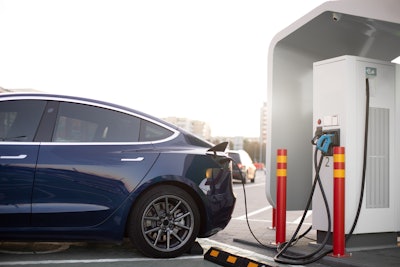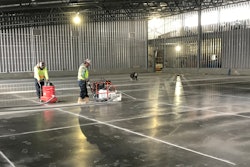
Congress passed the Bipartisan Infrastructure Law (Infrastructure Investment and Jobs Act) that primarily addresses the need to reinforce America’s roads, bridges, and rails. This includes investments in passenger rails, upgraded power infrastructure, investments in public transit, and an initiative to establish a network of electric vehicle chargers.
Many of these initiatives have been carried over from previous administrations for several decades, but the network of electric vehicle chargers is a new one. Current events have spotlighted this administration’s resolve in speeding up the country’s EV adoption rate for both consumer and commercial use. According to experts, electric vehicles (EV) made up 7.2% of global car sales in the first two quarters of 2021, up 4.3% from the previous year. In North America, EVs made up 3% of sales in the first half, but industry observers say 5% is possible as second-half sales pick up.
More than $200 billion in electric transportation investments contained in President Joe Biden's jobs and infrastructure plans, including purchase incentives, aim to accelerate the country’s electrification plans. This level of investment in EVs and charging infrastructure could create a tipping point for EV adoption. This would not only create a significant leap forward in reducing emissions from the transportation sector but will call on the steel conduit sector to build the needed infrastructure to support, and help push, the adoption of EVs.
The proliferation of consumer EV adoption and infrastructure planning are symbiotic, with much of the allocated budget going into materials needed for this large-scale, national project. For example, the measures create an EV charging equity program to direct $1 billion to increase EV charging in underserved communities and provide $7.5 billion in state grants for charging in low- and moderate-income communities. And $5 billion in grants and rebates would help replace heavy-duty trucks with electric versions while also supporting charging infrastructure. Those charging structures will need steel conduit raceways.
Steel Raceways for EV Proliferation
Steel conduit has been used as a “raceway system” for electrical conductors since the early 1900s. Steel conduit and tubing are the most resilient, protective, and durable electrical raceways.
There are many different types of steel raceways. From steel rigid metal conduit (RMC) to electrical metallic tubing (EMT), steel conduit can be used in various construction projects. The strength of steel used for electrical conduit has been recognized for decades as providing superior protection and efficiency. From skyscrapers to small business outlets, steel conduit and tubing can provide value for years after installation.
The benefits of steel conduit outweigh other options for their versatility, resilience, sustainability, and affordability – all considerations needed for an expansive project such as a national EV charge station infrastructure. As codes get more complex (National Electric Code, NFPA 70), many wiring methods are restricted; however, there is a steel conduit or tubing solution allowed everywhere. Additionally, steel conduit has been proven to be long-lasting and highly recyclable, which provides the greatest resiliency and sustainability in raceway options. One of the most significant benefits is flexibility and affordability. Other wiring solutions must be removed and reinstalled as buildings and projects evolve and expand however, steel conduit can continue to be used as conductors are replaced or additional circuits are added.
Many of today’s commercial structures are designed to last for lifetimes, and steel conduit is an essential component of modern electrical system longevity. Steel conduit resists all common forms of wear, ensuring long-lasting performance, which would be needed as charging stations would be exposed to various elements.
With a reputation for resiliency, steel conduit has been an industry staple for its superior protection against various elements. But as we face greater natural and artificial disasters, establishing a more robust infrastructure is increasingly essential. When considering the magnitude of building EV charging station infrastructure, steel conduit shines as the perfect electrical raceway because it allows for wiring to be removed, changed, updated, and reused, something that’s generally not feasible with other cabling methods. In cases of flooding, the conduit raceway can even be flushed out, cleaned, and prepared for new wiring. Lastly, the longevity and reusability of steel conduit supports sustainable building and environmentally responsible practices for their ability to be endlessly recycled and re-purposed.
Unlike other types of metal conduit, galvanized steel conduit can be used in concrete, direct burial, and areas with severe corrosive influences, providing a lifelong ability to protect against EMI (electromagnetic interference) shield. Given the nature of electric vehicle charging infrastructure buildouts, this benefit will be vital.
Steel Conduit’s Cost Savings and ROI
In this industry, it is commonly known that steel conduit can reduce costs. From installation throughout the life of a project, steel conduit does not require a ground wire to enhance the structure's safety, meaning budgeting for additional conductors is unnecessary. Steel conduit’s flexibility and reusability, even as structures change over time, enables preservation, saving the recurring expense of replacing cabling as the structure evolves.
Most commercial structures undergo renovations and upgrades every few years to accommodate new business needs, and it is safe to assume that EV charging stations will require similar consistent updates. It’s essential to consider this aspect when selecting a wiring method for a new structure because long-term costs can far outweigh savings on initial installation. This will be vitally important for EV charging stations, which will likely undergo many housing transformations over the next several decades. What might start as a simple charging station may turn into charging depots and even expand into full-service locations complete with c-store style shopping and restaurants.
The cost breakdown and ROI of using steel conduit for wiring must be observed in the initial installation and through reasonably common upgrades and maintenance processes needed over the lifetime within today’s practical and conservative construction and business climate. This will be particularly important for EV proliferation considering initial installation, light R&D conversions, and long-term retrofits for continued proofing. Considering the expansive project needed for EV proliferation in the United States, a significant cost saving can be applied to other, much-needed infrastructure upgrades. In a hypothetical cost-benefit analysis comparing EMT (electrical metallic tubing), or steel conduit, to MC cable, the 10-year cost comparison demonstrated a cost savings of nearly 30 percent for a hypothetical building consisting of three floors and a mix of retail and commercial office space.
The growing demand for EVs has fueled the requirement for charging stations nationwide. Steel, as raw material, and steel conduit are likely material sources to fulfill the need, making the adoption of EVs and the rollout of charging station infrastructures more affordable, sustainable and reliable. Infrastructure changes are large investments and can be slow moving, that’s why as we inevitably implement EV charging, smart choices now help secure the long-term value of these stations. The materials required (metals especially) will naturally propel to build the required infrastructure.
Dale L. Crawford is executive director and director of conduit of the Steel Tube Institute.





















